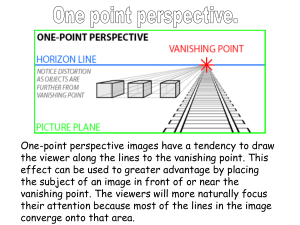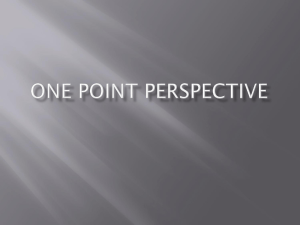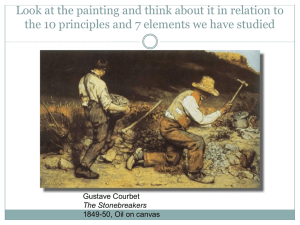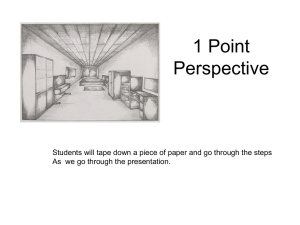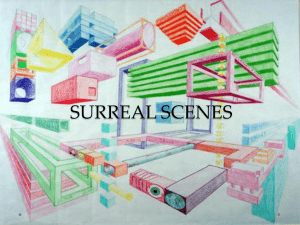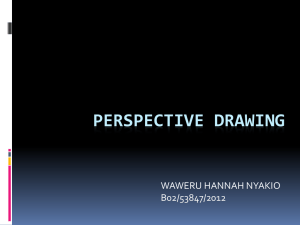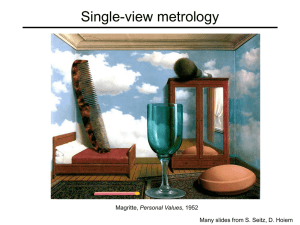single-view metrology lecture
advertisement
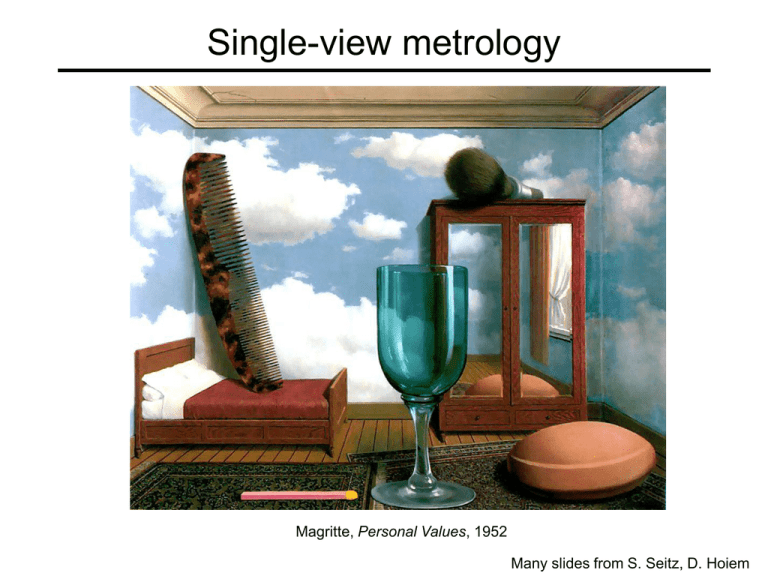
Single-view metrology Magritte, Personal Values, 1952 Many slides from S. Seitz, D. Hoiem Camera calibration revisited • What if world coordinates of reference 3D points are not known? • We can use scene features such as vanishing points Vertical vanishing point (at infinity) Vanishing line Vanishing point Vanishing point Slide from Efros, Photo from Criminisi Recall: Vanishing points image plane vanishing point v camera center line in the scene • All lines having the same direction share the same vanishing point Computing vanishing points v X0 x0 td1 y td 2 Xt 0 z0 td 3 1 • • • x0 / t d1 y /t d 2 0 z0 / t d 3 1 / t Xt d1 d X 2 d3 0 X∞ is a point at infinity, v is its projection: v = PX∞ The vanishing point depends only on line direction All lines having direction D intersect at X∞ Calibration from vanishing points • Consider a scene with three orthogonal vanishing directions: .v . v1 2 v3 • Note: v1, v2 are finite vanishing points and v3 is an infinite vanishing point Calibration from vanishing points • Consider a scene with three orthogonal vanishing directions: .v . v1 2 v3 • We can align the world coordinate system with these directions Calibration from vanishing points * * * * P * * * * p1 * * * * • • • • p2 p3 p4 p1 = P(1,0,0,0)T – the vanishing point in the x direction Similarly, p2 and p3 are the vanishing points in the y and z directions p4 = P(0,0,0,1)T – projection of the origin of the world coordinate system Problem: we can only know the four columns up to independent scale factors, additional constraints needed to solve for them Calibration from vanishing points • Let us align the world coordinate system with three orthogonal vanishing directions in the scene: 1 0 0 e1 0, e 2 1, e 3 0 0 0 1 ei i v i K R | t KRe i 0 ei i R T K 1 v i , eTi e j 0 v Ti K T RR T K 1 v j v Ti K T K 1 v j 0 • Each pair of vanishing points gives us a constraint on the focal length and principal point Calibration from vanishing points Cannot recover focal length, principal point is the third vanishing point Can solve for focal length, principal point Rotation from vanishing points ei i v i K R | t KRe i 0 i K 1 v1 Re1 [r1 r2 1 r3 ] 0 r1 0 1 Thus, i K v i ri . Get λi by using the constraint ||ri||2=1. Calibration from vanishing points: Summary • • • Solve for K (focal length, principal point) using three orthogonal vanishing points Get rotation directly from vanishing points once calibration matrix is known Advantages • • • No need for calibration chart, 2D-3D correspondences Could be completely automatic Disadvantages • • • Only applies to certain kinds of scenes Inaccuracies in computation of vanishing points Problems due to infinite vanishing points Making measurements from a single image http://en.wikipedia.org/wiki/Ames_room Recall: Measuring height 5 5.3 4 Camera height 3.3 3 2.8 2 1 Measuring height without a ruler O Z ground plane Compute Z from image measurements • Need more than vanishing points to do this The cross-ratio • A projective invariant: quantity that does not change under projective transformations (including perspective projection) The cross-ratio • A projective invariant: quantity that does not change under projective transformations (including perspective projection) • The cross-ratio of four points: P3 P1 P4 P2 P3 P2 P4 P1 P3 P4 P2 P1 • What are invariants for other types of transformations (similarity, affine)? Measuring height TB R R B T H R H R scene cross ratio T (top of object) t b vZ r t r C vZ b R H (reference point) R B ground plane (bottom of object) r b vZ t image cross ratio Measuring height without a ruler vz r vanishing line (horizon) t0 vx t vy v H R b0 t b vZ r H r b vZ t R image cross ratio b H 2D lines in homogeneous coordinates • Line equation: ax + by + c = 0 a x T l x 0 where l b , x y c 1 • Line passing through two points: l x1 x 2 • Intersection of two lines: x l1 l 2 • What is the intersection of two parallel lines? vz r vanishing line (horizon) t0 vx t vy v H R b0 t b vZ r H r b vZ t R image cross ratio b H Measurements on planes 4 3 2 1 1 2 Approach: unwarp then measure What kind of warp is this? 3 4 Image rectification p′ p To unwarp (rectify) an image • solve for homography H given p and p′ – how many points are necessary to solve for H? Image rectification: example Piero della Francesca, Flagellation, ca. 1455 Application: 3D modeling from a single image J. Vermeer, Music Lesson, 1662 A. Criminisi, M. Kemp, and A. Zisserman, Bringing Pictorial Space to Life: computer techniques for the analysis of paintings, Proc. Computers and the History of Art, 2002 http://research.microsoft.com/en-us/um/people/antcrim/ACriminisi_3D_Museum.wmv Application: 3D modeling from a single image D. Hoiem, A.A. Efros, and M. Hebert, "Automatic Photo Pop-up", SIGGRAPH 2005. http://www.cs.illinois.edu/homes/dhoiem/projects/popup/popup_movie_450_250.mp4 Application: Image editing Inserting synthetic objects into images: http://vimeo.com/28962540 K. Karsch and V. Hedau and D. Forsyth and D. Hoiem, “Rendering Synthetic Objects into Legacy Photographs,” SIGGRAPH Asia 2011 Application: Object recognition D. Hoiem, A.A. Efros, and M. Hebert, "Putting Objects in Perspective", CVPR 2006
